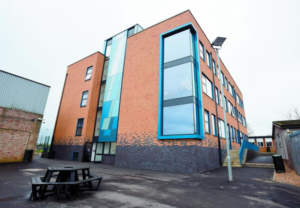
Furze Platt Senior School
Furze Platt Senior School is designed to use natural ventilation and natural light first, greatly reducing the energy bills. The teaching block also features a small solar panel array that contributes 10% of the building’s energy.

The new school hall is a flexible space for activities ranging from small dance classes to whole school assemblies and theatrical performances. Following our design, it is naturally ventilated using windcatcher towers to provide a constant flow of fresh air and heated with super-efficient heat pumps.Furze Platt Senior School is an Academy school located in Maidenhead Berkshire. Banyards were appointed to provide a performance design for a new 3-storey Science, IT and General Teaching block to replace an existing single storey building on the campus. We collaborated on the project with Atkins architects to create a low energy building with hybrid ventilation, passive cooling, and extensive use of natural light via large façade windows in the classrooms and additional light entering from the central atrium at the rear. The building was designed for compliance with the department for Education’s Facilities Output Specification (FOS) and a significant amount of time was spent studying the building in a thermal modelling environment to create low energy, world-class learning environments for the students. The building is heated by underfloor heating supplied by energy-efficient modular condensing boilers. Additionally, a portion of the building’s electricity is generated by roof-mounted solar panels.

Furze Platt Senior School was the largest of 4 school extension projects that Banyards completed for the client alongside Atkins so challenges in achieving compliance with the DfE’s Facilities Output Specification (FOS) were largely resolved through our work on the previous 3 schools (Charters, Cox Green, Dedworth). Banyards worked closely with Atkins to design the building façade that delivers high levels of natural light and fresh air that interacts with the thermal mass of the structure to give a natural cooling effect. Banyards have taken the principles from this approach to other successful projects with different clients and architects. We have used the lessons learned to help us adapt our approach to suit the new DfE Output Specification which has subsequently superseded the FOS.
PLEASE READ THE TERMS OF THIS POLICY CAREFULLY BEFORE USING THE [BANYARDS’ PORTAL]
What’s in these terms?
This acceptable use policy sets out the terms that apply when you access or interact with the Banyards’ Portal.
Who we are and how to contact us
Our site is operated by Banyard Consultants Ltd (“We”). We are a limited company registered in England under company number 3847976. Our registered office is 28-30, Worship Street, London, EC2A 2AH. Our VAT number is GB 826 7615 08.
By using our site you accept these terms
By using our site, you confirm that you accept the terms of this policy and that you agree to comply with them.
If you do not agree to these terms, you must not use our site.
We recommend that you print a copy of these terms for future reference.
There are other terms that may apply to you
Our website Terms and our Privacy Notice also apply to your use of our site.
Portal Content
The Banyards’ Portal allows you to access information reports, data and test results to check and monitor the progress of work undertaken by third party contractors at your site. You may only use the Banyards’ Portal for the purpose of accessing information in relation to Projects administered by us for you.
Access to the Banyards’ Portal
At the commencement of each Project you will be provided with a unique login password to enable you to access the Banyards’ Portal. This will then enable you to review the current status on your various Projects. You are responsible to ensure that the login password will only be given to those of your employees, agents or advisers whom you wish to access information from the Banyards’ Portal.
By accessing the Banyards’ Portal you will be able to review and download copies of information that are posted by us on your Client Portal.
Updating of Information
Information will be regularly updated by us and in any event within 7 days of verification by us of information provided by your contractors.
All information and data uploaded from time to time to your portal will be correct [at the time of upload].
If for any reason, outside our control, we are unable to upload information to the Banyard’s Portal then we will let you know by posting a message on our website and we will take all reasonable steps to minimise any delays in so doing.
If we fail to upload information to Banyards’ Portal in accordance with these terms and such failure arises from any delay on the part of your contractors or the supply by them of inadequate or incorrect information, then we shall have no liability to you arising from such delays or the uploading of incorrect or misleading information provided to us.
We may make changes to the terms of this policy
We amend these terms from time to time. Every time you wish to use our site, please check these terms to ensure you understand the terms that apply at that time.
Breach of this policy
When we consider that a breach of this policy has occurred, we may take such action as we deem appropriate.
Failure to comply with this policy constitutes a material breach of the terms of use upon which you are permitted to use our site, and may result in our taking all or any of the following actions:
We exclude our liability for all action we may take in response to breaches of this acceptable use policy. The actions we may take are not limited to those described above, and we may take any other action we reasonably deem appropriate.
Which country’s laws apply to any disputes?
The terms of this policy, its subject matter and its formation (and any non-contractual disputes or claims) are governed by English law. By using our site you agree to the exclusive jurisdiction of the courts of England and Wales.
Effective Date
These Terms are effective from January 2019